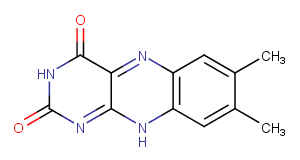Powder: -20°C for 3 years | In solvent: -80°C for 1 year


Lumichrome (7,8-Dimethylalloxazine) is a natural metabolite of riboflavin. Lumichrome produced by Rhizobium and other bacterial species induces major developmental changes in plants at nanomolar concentrations. Lumichrome can stimulate larval metamorphosis in ascidians and activate the LasR quorum sensing receptor of bacteria. Lumichrome competitively inhibits the uptake of riboflavin by riboflavin transporters from prokaryotes and eukaryotes.

| Pack Size | Availability | Price/USD | Quantity |
|---|---|---|---|
| 50 mg | In stock | $ 42.00 | |
| 100 mg | In stock | $ 66.00 |



| Description | Lumichrome (7,8-Dimethylalloxazine) is a natural metabolite of riboflavin. Lumichrome produced by Rhizobium and other bacterial species induces major developmental changes in plants at nanomolar concentrations. Lumichrome can stimulate larval metamorphosis in ascidians and activate the LasR quorum sensing receptor of bacteria. Lumichrome competitively inhibits the uptake of riboflavin by riboflavin transporters from prokaryotes and eukaryotes. |
| Source |
| Synonyms | 7,8-Dimethylalloxazine |
| Molecular Weight | 242.23 |
| Formula | C12H10N4O2 |
| CAS No. | 1086-80-2 |
Powder: -20°C for 3 years | In solvent: -80°C for 1 year
DMSO: Soluble
H2O: Soluble
You can also refer to dose conversion for different animals. More
bottom
Please see Inhibitor Handling Instructions for more frequently ask questions. Topics include: how to prepare stock solutions, how to store products, and cautions on cell-based assays & animal experiments, etc.
Lumichrome 1086-80-2 Others Endogenous Metabolite Inhibitor p53 photodegradation product endogenous 7,8-Dimethylalloxazine Apoptosis human lung cancer cell growth inhibit inhibitor
